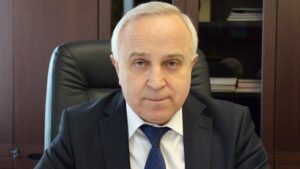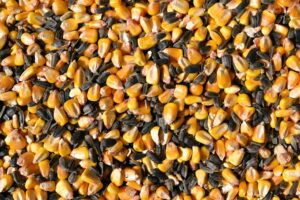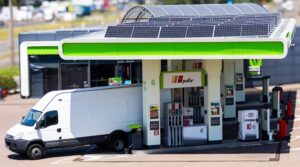
Current trends and drivers of cryptocurrency growth
Institutional involvement and legislation
ETFs and ICO activity
Real-world asset (RWA) tokenization
Technologies and AI tokens
Security and hacker attacks
Forecast for the end of July and August
Bitcoin (BTC)
Ethereum (ETH)
Growth and pressure factors
Growth.
Risks:
Source: https://www.fixygen.ua/news/20250722/oglyad-kriptovalyut-na-22-chervnya-2025-roku-vid-fixygen.html

The interest of foreigners in purchasing premium housing in Ukraine for investment purposes is gradually recovering, developers toldInterfax-Ukraine.
“The interest of foreigners has recovered and in some cases, for example, in our projects, the number of transactions with foreigners exceeds the number of transactions with Ukrainians. Among our clients are Spaniards, Japanese, Canadians and others who invest in business and premium class with a clear view to the future. They see the potential in both long-term lease and value growth,” said Irina Mikhaleva, CMO of Alliance Novobud.
According to Susanna Karakhanyan, Director of Sales at Greenville, foreign clients are considering both investment purchase of apartments and housing for themselves, but they are postponing the purchase until safer times.
“Interest from non-residents has partially recovered recently. We note a trend that foreigners regularly visit apartment inspections, but do not buy yet – they are waiting for stabilization in Ukraine,” she explained.
Although the majority of the housing of the Odesa-based developer Dva Akademika is bought by local residents (up to 60% of clients), the share of transactions with foreign investors has increased over the past year and a half, the company said.
“In terms of geography, 55-60% are local residents, in our case, Odesa. Up to 30% are other cities of Ukraine. However, over the past year, these figures have begun to change with the emergence of foreign investors. In the period 2024-2025, 35% of transactions are concluded with foreign investors: UAE, Slovakia, Turkey, Italy, USA, Greece, Israel and Romania,” said Maxim Odintsov, Development Director of Dva Akademika Construction Company.
In addition, foreigners’ demand remains for Ukrainian residential projects where foreign companies are involved as partners, according to RIEL.
“We have projects that are quite actively sought after by foreigners. For example, Maxima Residence has traditionally been of interest to foreigners, in particular Turkish citizens. This is due to the fact that it is a joint project of RIEL and the Turkish developer Bosphorus Development,” explained Zoryana Zemlynska, coordinator of RIEL’s sales department in Kyiv.
At the same time, KAN Development noted that the share of foreigners among buyers remains insignificant, and the demand for premium housing is mainly recovering due to people who invested before the war.
“The share of foreigners among buyers remains insignificant. These are mainly those who are considering investing with an eye to the minimum cost of entry into the market,” the developer’s press service said at the request of Interfax-Ukraine.
According to Oleksandr Nasykovsky, managing partner of DIM Group, Ukrainians who have been living abroad for a long time have appeared in the structure of demand for premium housing.
“We observe the following trend: some buyers who have free funds do not deliberately withdraw them abroad, but ”park” them in real estate with an eye to price growth in the future and preservation of asset value. As for foreign nationals, we do not see any activity on their part for reasons that are clear to everyone. However, there is a small share of Ukrainians who have been living abroad for a long time,” the businessman said.

Yaroslav Hadzalo, President of the National Academy of Agrarian Sciences of Ukraine (NAAS), has been suspended from office by the Pechersk District Court of Kyiv until the pre-trial investigation is completed.
“In addition to the removal from office, the court partially granted the prosecutor’s request for a preventive measure, imposing a number of duties on the suspect… Due to the leniency of the chosen preventive measure, the prosecution filed an appeal, as it reasonably believes that there are risks of the suspect’s influence on the course of the investigation,” the Prosecutor General’s Office website said on Tuesday morning.
The NAAS President is suspected of aiding and abetting the embezzlement of budget funds committed by a group of persons by prior conspiracy (Part 5 of Article 27, Part 3 of Article 191 of the Criminal Code of Ukraine).
“He employed his driver at four state-owned agricultural enterprises controlled by him. In fact, the driver did not work there, but only drove the President of the National Academy of Sciences in the company car of one of the enterprises. In 2020, the president of the National Academy of Sciences personally approved the staffing tables, knowing that the same driver was involved in each of the enterprises. This allowed him to pay salaries for work that was not actually performed. As a result of these actions, money was paid from the budget for fictitious work,” the State Bureau of Investigation website reports.
It is reported that the personal driver of the President of the National Academy of Sciences received a salary totaling more than UAH 200 thousand from the state budget.
As reported, the Office of the Prosecutor General opened criminal proceedings on abuse of office by NAAS officials back in August 2020, after which Hadzalo was charged with a number of suspicions and repeatedly removed from office. In particular, he was suspected of assisting in the appointment of the head of a state-owned enterprise, interfering with the activities of an executive service employee, and transferring 150 thousand hectares of the Academy’s agricultural land to private individuals. Gadzalo denied that the Academy’s management received funds for the transfer of land under the control of other persons.

The sales rates in the season-2024 were significantly higher compared to the previous year, especially for corn and sunflower, Agrohub reported based on the results of two waves of research on the efficiency and effectiveness of growing the main crops of the season-2024.
“At the time of the first wave of the study (end of January 2025), the percentage of sales of these crops was more than 60%, while at the end of January 2024, only 25% of corn and 27% of sunflower were sold,” the researchers said.
According to the study, sunflower was sold almost completely, which was due to a decrease in its share in the crop structure and high demand from the processing industry, as well as an increase in the number of oil extraction plants. For export-oriented crops, a stable sea export corridor plays an important role in shaping the sales rate: despite the threats and shelling of port infrastructure, it remained the most effective channel for selling products, analysts say.
The positive price situation was the main factor behind the growth of profitability of agricultural production in 2024, the report says. Thus, the break-even point decreased in many crops, while the profitability indicators increased. According to the results of the season-2024, the average forecast EBITDA for such crops as winter wheat, rapeseed and barley, as well as sunflower and corn amounted to $402 per 1 ha, which exceeded last year’s forecast level of $94 per 1 ha, i.e. 4.3 times, Agrohub calculated.
The analysts reminded that the forecast EBITDA is an expected estimate of profitability per hectare, calculated on the basis of current selling prices of already sold products and forecast prices for the residues.
Experts identify sunflower, corn, and rapeseed as the crops with the highest expected profitability in the 2025 season.
Despite the fact that in the 2024 season the yields of the studied crops decreased, the positive price dynamics during the year allowed not only to maintain but also to increase the profitability of crops. The main reason for the decrease in yields was drought and heat in the central, southern and eastern regions. Soil temperatures in summer reached above +60°C, and local rains failed to save the situation. In the West, where there is traditionally more rainfall, the yield decline was not significant, the researchers emphasized.
In addition, analysts drew attention to an interesting trend in the dynamics of costs, which has been observed for two seasons in a row. In particular, the costs of growing decreased slightly – within 8% for sunflower and rapeseed, mainly due to the reduction of fertilizer costs. At the same time, crop protection costs for sunflower and corn decreased by 11% due to dry weather conditions. Lower yields per hectare and dry weather conditions resulted in lower costs for transportation and grain processing, as the average moisture content of harvested corn in the 2024 season was 16.7% compared to 19.8% a year ago.
“The 2024 season illustrated how the agricultural business in Ukraine is learning to adapt to complex challenges: from war and unstable logistics to climate change and lack of resources. Increasing profitability and efficiency in such conditions is the result of flexibility, strategic planning and proper agricultural practices,” Oksana Bobrova, Head of Agrohub Benchmarking, summarized in her statement.
The study of the first and second waves of efficiency and effectiveness indicators of the main crops of the 2024 season, conducted by Agrohub, involved 14 largest Ukrainian agricultural holdings. The total area of analysis covered 1.7 million hectares in eight macro-regions of Ukraine.
The data on crop sales in the 2024 season are based on Agrohub’s research conducted in January-May 2025 among 83 field companies with a total area of 1.7 mln ha. The area of the studied crops: sunflower – 302.5 thou hectares, corn – 363.4 thou hectares, soybeans – 411.2 thou hectares, winter wheat – 403.5 thou hectares, winter rapeseed – 169.5 thou hectares and winter barley – 18 thou hectares.

The total capacity of SPPs in the network of OKKO filling stations has reached 5.9 MW: these are stations at 244 filling stations, 40 of which were put into operation in the first half of 2025, the company’s press service reports.
“In the first half of 2025, OKKO commissioned rooftop SPPs at 40 more filling stations, as well as on the building of its trucking company. Thus, 244 filling stations of the network are already meeting part of their electricity needs with sunlight. Their total capacity now reaches 5.9 MW,” the company said in a release on Monday.
It is specified that the capacity of its rooftop SPPs is mainly 15-25 kW, although there are several stations with 50-65 kW.
“Depending on the capacity, electricity consumption, configuration, and other factors, one such SPP can cover 15% to 55% of the daily consumption of gas stations during the period of active generation,” the company said.
According to the press release, OKKO intends to continue solar electrification of its filling stations, and in the coming years, rooftop SPPs may be installed at about 100 more of them, where there are technical possibilities for this.
It is specified that OKKO will invest UAH 30 million (including VAT) in the SPP project at its filling stations in 2025.
“It is expected that in 2025 the total generation of solar stations at OKKO filling stations will exceed 5 million kWh,” the release says.
As reported with reference to Vasyl Danyliak, CEO of OKKO Group, OKKO Group, which includes the operator of the eponymous filling station network, Concern Galnaftogaz, plans to have approximately 600 MW of capacity in wind power, 200 MW in solar power and 150 MW in energy storage facilities over the next five years.
The network under the OKKO brand includes approximately 400 filling stations.

Tea and coffee production in Ukraine involves 570 business entities, in 2024 they earned UAH 10 billion, which is 19% more than in 2023, when their revenue amounted to UAH 8.6 billion, according to a study by YouControl.
It is noted that as of July 2025, there are 570 business entities in Ukraine that are not in a state of termination, registered and conducting financial activities under CEA 10.83 “Production of tea and coffee”. In particular, 264 operate in the form of companies, and 306 are individual entrepreneurs. Most of them are concentrated in Kyiv – 153 entities, in Dnipropetrovska (54) and Kyiv (48), Lviv (40) and Odesa (36) regions.
The analysts noted that among the analyzed companies there are also legal entities with foreign capital, in particular from China, India, Turkey, as well as Cyprus, Moldova and other European countries.
According to the study, the ten largest tea and coffee companies in Ukraine earned a total of UAH 7.9 billion, which is 79% of the total revenue of companies that submitted financial statements for 2024.
According to YouControl, the leaders of the coffee market are Monomakh JSC with UAH 2.3 billion in revenue, Fes Ukr LLC (MacCoffee and HILLWAY brands) with UAH 2 billion, Galka Ltd and Coffee from Lviv LLC (Galka and Coffee from Lviv brands) with UAH 1.63 billion, and Vienna Coffee LLC (Vienna Coffee brand) with UAH 526 million, TC Trade LLC (brands Greenfield, TESS, Princess Nuri, etc.) – UAH 408 million, Food Pack LLC (brand Gemini) – UAH 373.6 million, Trypillian Sun LLC (brands Trypillian Sun, Sherlock Secrets, Tea Moments, Tea Family) – UAH 323 million, Ukrainian Coffee Company LLC (brands GALEAD’OR, XO, 1CUP, 1CUPsule. Inspiro Gusto, 1CUPsule. EGO, RIO NEGRO, LEONARDO) – UAH 280 million, SUB LLC Ukrainian Tea Factory Ahmad Tee (Ahmad Tea brand) – UAH 187.3 million, LLC Lisova Skazka (Lisova Skazka, Tea Collection, EcoTea brands) – UAH 165 million.
“Unfortunately, the market leaders are not without ties with the aggressor,” the resource noted and added that this thesis applies to half of the rating participants.